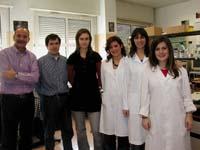Detection of Salmonella in 24 hours

In 2002, the Department of Immunology, Microbiology and Parasitology of UPV-EHU realized the need to develop faster methods of detecting Salmonella in food, and a research project was launched in collaboration with the Alava company Laboratorios Bromatológica Araba and the Leia technological center.
Genetic methods Genetic methods
Research began in the field of genetic methods. For this it is essential to know well the genome of the bacteria. Fortunately, several strains of Salmonella are perfectly sequenced. They also know that there are Salmonella genes that do not appear in other bacteria or living things. Therefore, if these genes are detected, it can be clearly observed where the bacterium of Salmonella is. Although the entire microorganism is not detected, we would find its DNA.
Investigating the DNA of the bacteria, researchers have developed different techniques that detect the presence of Salmonella in food for 24 hours. However, these methods based on DNA detection have a problem: The DNA molecule is very stable. Precisely for this reason, the DNA of deceased persons can be analyzed many years before. Something similar can occur in bacteria. That is, it is possible that the DNA of the dead bacteria is being studied in pasteurization and/or sterilization. Therefore, to detect Salmonella it is not enough to study the DNA, since in this way it is not possible to know if the bacteria is alive or dead.
Therefore, UPV researchers have used another more specific marker that will indicate whether the bacteria is alive or not. This molecule is a messenger RNA. It is an unstable molecule, easily degradable. It only appears when the bacteria is alive. Once the bacteria die, it disappears along with the bacteria. Aware of this, UPV researchers have developed the detection of RNA. On the one hand, an RNA extraction process has been designed in food and, on the other, it has been studied how to convert this RNA into DNA. Detection techniques work with DNA.

Work with RNA with great precision and speed. Otherwise, it is possible that the results are not correct and that the foods in which the bacterium Salmonella is found receive reverse results due to the degradation of the molecule. Therefore, the RNA extraction process is as basic as it is important.
Once the messenger of the RNA has been extracted, they convert it into DNA through the process called reverse transcription. In this process, a copy of DNA is synthesized. To detect the specific DNA sequence of Salmonella, PCR has been used in real time. This copy of the DNA is detected by several probes. The probes are auxiliary strings of Salmonella's DNA and are marked by a fluorescent compound. If in this technique the copy of the DNA is combined with the auxiliary chain, this fluorescent compound emits a signal. This apparatus also allows to quantify the reaction, that is, it shows the number of Salmonella cells present in the food. The results of the PCR are analyzed using graphs and an interpretation is performed.
In short, UPV researchers combine different techniques. On the one hand, they use extraction techniques, on the other, design probes and, finally, detect DNA and RNA molecules. The use of these latest techniques allows accelerating the detection of Salmonella bacteria and increasing food safety.






